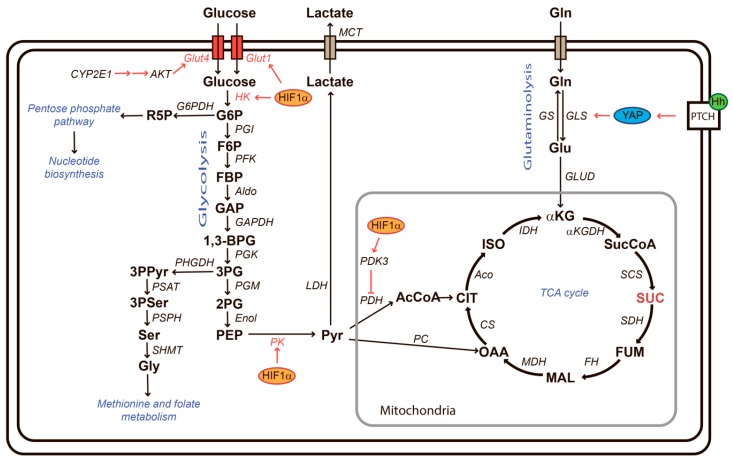Figure 4.
Central carbon metabolism. Glucose is taken up by glucose transporters (Glut) and then phosphorylated by hexokinase (HK) to produce glucose-6-phosphate (G6P). G6P can be channeled by glucose-6-phosphate dehydrogenase (G6PDH) into the pentose phosphate pathway for nucleotide production. Alternatively, G6P can be converted to fructose-6-phosphate (F6P), fructose-1,6-bisphosphate (FBP), glyceraldehyde 3-phosphate (GAP), 1,3-bisphosphoglycerate (1,3-BPG), and 3-phosphoglycerate (3PG) under catalysis of phosphoglucoisomerase (PGI), phosphofructokinase (PFK), aldolase (Aldo), glyceraldehyde dehydrogenase (GAPDH), and phosphoglycerokinase (PGK), respectively. 3PG is a precursor for de novo serine synthesis via 3-phosphopyruvate (3PPyr) and 3-phosphoserine (3PSer). Serine is converted to glycine to feed methionine and folate metabolism (one carbon metabolism). Serine/glycine biosynthesis is catalyzed by phosphoglycerate dehydrogenase (PHGDH), phosphoserine aminotransferase (PSAT), phosphoserine phosphatase (PSPH), and serine hydroxymethyltransferase 2 (SHMT2). Alternatively, 3PG is converted into pyruvate (PYR) via 2-phosphoglycerate (2PG) and phosphoenolpyruvate (PEP) with phosphoglyceromutase (PGM), enolase (Enol), and pyruvate kinase (PK) catalysis. Pyruvate is imported into mitochondria and either channeled to the tricarbonic acid (TCA) cycle via pyruvate dehydrogenase (PDH)-catalyzed formation of acetyl coenzyme A (AcCoA) or via pyruvate carboxylase (PC). Pyruvate can be also transformed into lactate through lactate dehydrogenase (LDH) and then be exported from a cell via monocarboxylate transporters (MCT). Glutamine can also serve as substrate for the TCA cycle. Glutaminolysis refers to the import of glutamine (Gln) and its conversion into glutamate (Glu) and α-ketoglutarate (αKG) through glutaminase (GLS) and glutamate dehydrogenase (GLUD). Within the TCA cycle, αKG is converted into succinyl-CoA (SucCoA), succinate (SUC), and fumarate (FUM) via α-ketoglutarate dehydrogenase (αKGDH), succinyl-CoA synthetase (SCS), and succinate dehydrogenase (SDH), respectively. Fumarate is converted into citrate (CIT) via malate (MAL) and oxaloacetate (OAA), and these reactions are accomplished by fumarase (FH), malate dehydrogenase (MDH), and citrate synthase (CS). Finally, citrate converted by aconitase (Aco) to isocytrate (ISO), and the latter is isomerized and then transformed into αKG with isocitrate dehydrogenase (IDH). Hypoxia-inducible factor 1α (HIF1α) upregulates expression of Glut1, HK2, PK, and PDK3, thus enhancing glycolysis but preventing shuttling of pyruvate into the TCA cycle. Cytochrome P450 2E1 (CYP2E1) activates a cascade (see the text for details) which leads to phosphorylation of alpha serine/threonine-protein kinase (AKT) and concomitant increase in Glut4 expression, thus also contributing to stimulated glycolysis. The Hedgehog (Hh)-YAP pathway upregulates expression of glutaminase 1 (GLS1). A TCA cycle intermediate succinate (also shown in red) may contribute to fibrogenesis by activating G protein-coupled receptor 91 (GPR91), also known as a succinate receptor.

